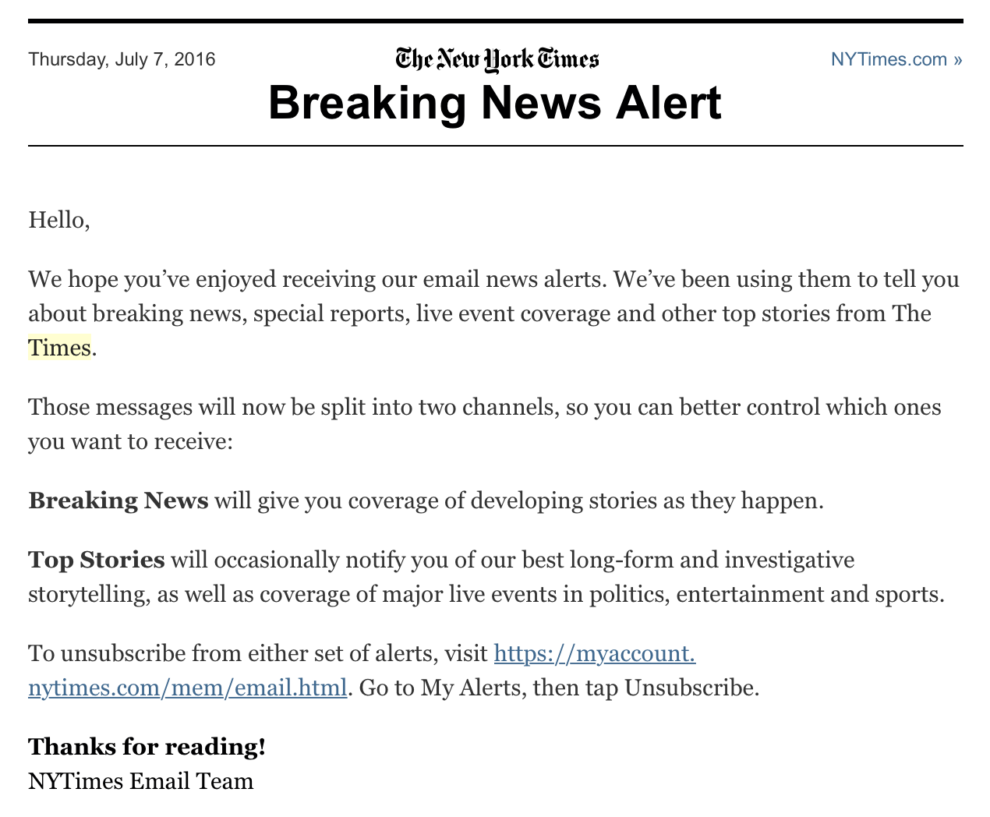
As we’ve already learned last year, sending the right push notification at the right moment is one of the biggest challenges of today’s newsrooms. With an eye on the most recent updates of The New York Times, let’s have a look at their strategy for push alerts and how other publishers like The Guardian, BuzzFeed and WSJ are approaching this matter.
It is known that there are some people blocking push alerts immediately after their first visit in the app, but there are some others that actually want to be notified when something happens. Then, while some of these readers appreciate when they receive notifications about top stories, others would prefer to be alerted about breaking news only. Today, NYTimes allows their readers to have full control over which kind of alerts they want to see.
In an email to subscribers, The Times has announced two weeks ago that they have created two spate channels for its email news alerts. This allows readers to sign up for separate braking news and top stories emails:

“We want to make sure that people can find out about those great stories, whether it’s via email or via push, but also be sensitive to those who don’t want to get that content on those channels,” said Eric Bishop, assistant editor for mobile.
The New York Times first introduced the concept of customizable push notifications in 2014, with a sole purpose of increasing the user engagement, giving readers the ability to filter the news according to their personal interests. Users can subscribe to one or all topics, including top stories and breaking news categories.
The new feature is already available on web and, according to Bishop, will soon be available on their mobile apps as well. Thus, on the NYTimes mobile apps subscribers will be able to choose on which topics they will receive notifications: Breaking News, Top Stories, Business & Tech, New York – related news, Politics and Sports.
“We’re figuring out how much to do this — what type of language to use to describe stories like this, how to signal why we think it’s so important that we’re going to push it to your lock screen. Those are all very real questions that we wrestle with in the newsroom on a daily basis, but we do know that there’s an appetite for that type of stuff among readers. We also know that some readers see that space as something that should be reserved for breaking news only,” said Eric Bishop.
Interesting is to look at the various approaches of push notifications among different publishers. While The New York Times has put together a team of 11 people solely dedicated to messaging and push alerts, and is focusing on the notifications’ wording, timing and type, some of their competitors have approached different strategies.
The Guardian, for instance, is building additional functions into their app to allow greater customization of the push notifications. If you are visiting sport stories more than other topics, The Guardian is using your behavioral data to send personalized push notification about sports.
The Wall Street Journal, in the same manner as NYTimes, is offering their subscribers the option of choosing to receive push alerts about Breaking News and/or Election 2016.
BuzzFeed on the other hand is focusing more on the question “Will the reader appreciate this?” before sending alerts to its subscribers.
“We think news alerts can go beyond regurgitating headlines and do more for readers than compel them to click through to a story because the alert didn’t provide all the information it could have in the first place,” said Sam Kirkland, the Mobile News Editor of BuzzFeed.
Publishers are continuing to experiment with personalizing push notifications, but choosing the right message to be sent to the right audience, at the right timing remains one of the biggest challenges of the industry.
What is your approach to push notifications? Book a meeting with our experts to discuss the various options of engaging more readers.
